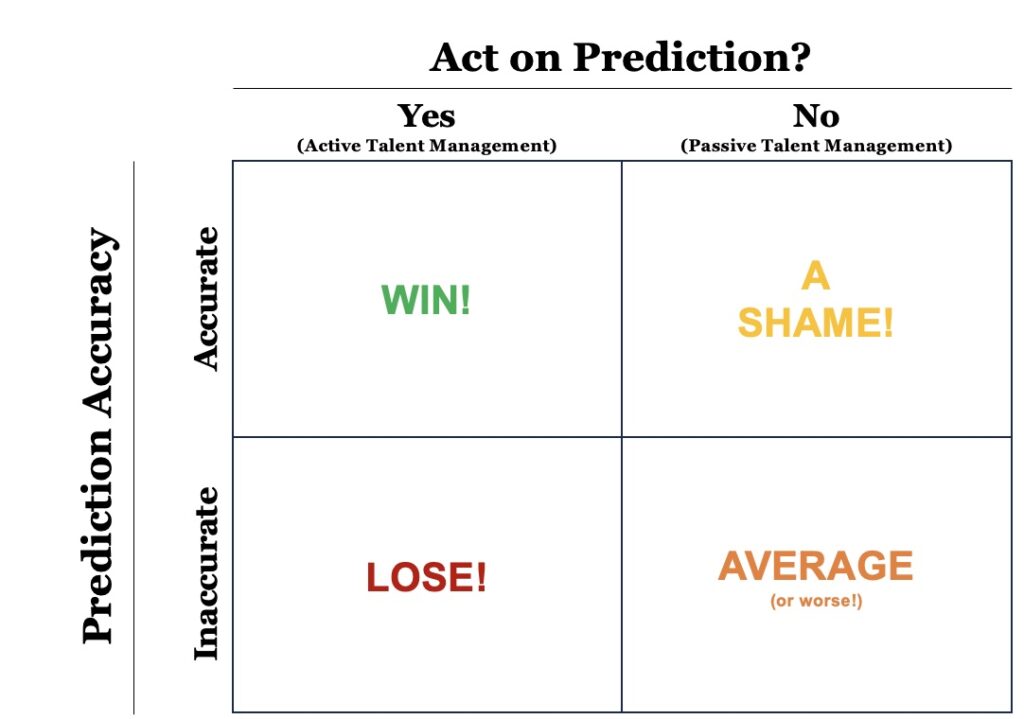Conundrums in Predicting an Employee’s “Potential”

Post content
At a recent dinner, a client steered the topic towards assessing the potential of talent. She asked me to share my insights on predicting the leadership potential of employees (defined as the ability to build and lead teams of increased scope and complexity to outperform the competition), to which I shared my musings summarized as:
- Predicting potential is easy
- Being accurate in predictions of potential is hard
- Acting on the prediction of potential is necessary
- You risk losing or being wrong
- But you have no choice but to do it
Predicting Potential is Easy
We predict potential every day. During a recent trip to the grocery store, I observed an individual standing before an apple stand pondering which apple to purchase. Amidst a vast selection of well over 400 apples, the individual swiftly made their decision, opting for a moderately ripe red delicious apple that promptly found its place amongst other produce in their cart. Through the interaction, this individual made an assessment on the potential of that apple – guided by factors such as its optimal ripeness in relationship to its expected use date, the apple type based on the intended use of the apple, and so on.
Similarly, at work we regularly make decisions in whom to enlist on a project team. In horse racing, we predict the potential of a horse to perform highly in the future based on the racetrack conditions, weather, and other key variables. The act of predicting potential is something that we all do, often without a second thought. Simply put, predicting potential is easy.
Accurately Predicting Potential is Hard
William Shakespeare in Macbeth states, “if you can look into the seeds of time and say which grain will grow and which will not, speak unto me.” On this, I agree with Shakespeare. If predicting potential were as easy as was described, then this would be a very short memo. But few are consistently accurate in their predictions of potential. Therein lies a conundrum – we often make predictions of potential with ease, but our ability to achieve reliable and consistent accuracy of that prediction is hard.
Conundrum #1: We often make predictions of potential with ease, but our ability to achieve reliable and consistent accuracy of that prediction is hard.
Moreover, the correlation between the accuracy of potential predictions and time follows a clear pattern: The further into the future that we extend a prediction, the greater the array of outcomes, making the accuracy of prediction more ambiguous. This illustrates the difficulty in getting predictions of potential correct. Therein lies a second conundrum – the most valuable predictions are those in the future. But, the further out we look, the greater the variability in the predictability of outcomes.
Conundrum #2: The most valuable predictions are those in the distant future. But, the further out we look, the greater the variability in the predictability of outcomes.
Acting on the Prediction of Potential is Necessary
During my formative childhood years, my healthy imagination concocted a variety of business ideas, one of which was a door-to-door seasonal giftwrapping service. However, recognizing the considerable effort expended for each customer, I revisited the customer acquisition model. Rather than go door to door, I’d park myself where the prospective customers were already shopping!
After careful deliberation, I scouted the optimal location – a high traffic walkway next to the Borders bookstore (may Borders Bookstore rest in peace!). With my plan finalized, I shared the business idea with everyone: family, friends, teachers. And yet, I never put the plan into action. A few years later, I walked by the Borders in December and witnessed an intriguing sight – there was a fully staffed gift-wrapping service, wrapping substantial volumes of gifts. Seeking validation for my unrealized prediction, I turned to my father, “See, I told you that spot was an exceptional location to sell giftwrapping services.” In return, he rightly stated, “What’d you gain for being right?”
The path to transforming predictive insights into value rests not only in accurately predicting potential but also in translating the accurate predicting into action. Therefore, the only way to derive accretive value from predictions of potential is to both accurately predict potential AND to act on that prediction.
I represent the relationship between accuracy and action in the following 2×2 matrix where on one axis, there is the accuracy of a prediction of employee potential and on the other axis, the actioning based on the prediction:

You Risk “Losing” or Being Wrong
Businesses succeed when they make accurate predictions about their employees’ potential and act on those predictions to realize that potential and maximize value creation. Conversely, making inaccurate predictions about potential and acting on those predictions results in losses (investments with little to potentially negative returns). Therein lies yet another conundrum – assessing potential and acting on that assessment can lead to differentiated organizational success, where a company “wins” compared to others… but it also brings the risk of “losing.”
Therefore, for an organization to create value above the norm, it must make more accurate predictions than inaccurate ones, both absolutely and in comparison to competitors.
Conundrum #3: Assessing talent and acting on that assessment can lead to differentiated success but it also brings the risk of “losing.”
Furthermore, when an organization fails to take action based on its predictions of potential, the entire exercise loses its value. Unfortunately, this is a common scenario in many organizations, where substantial time and resources are invested in assessing and refining employee potential predictions, yet these predictions are not translated into active Talent Management interventions (development, rewards, etc.). Passive Talent Management strategies applied to accurate predictions of employee potential is a shame because no prospective value of the prediction is realized.
But… You Have No Choice But to Predict & Act on Potential
Electing to not participate means the organization can never hope to be anything but average as the most talented individuals may leave for better opportunities, with competitors who do invest in their potential and growth. To borrow a phrase, “You can’t win if you don’t play.”